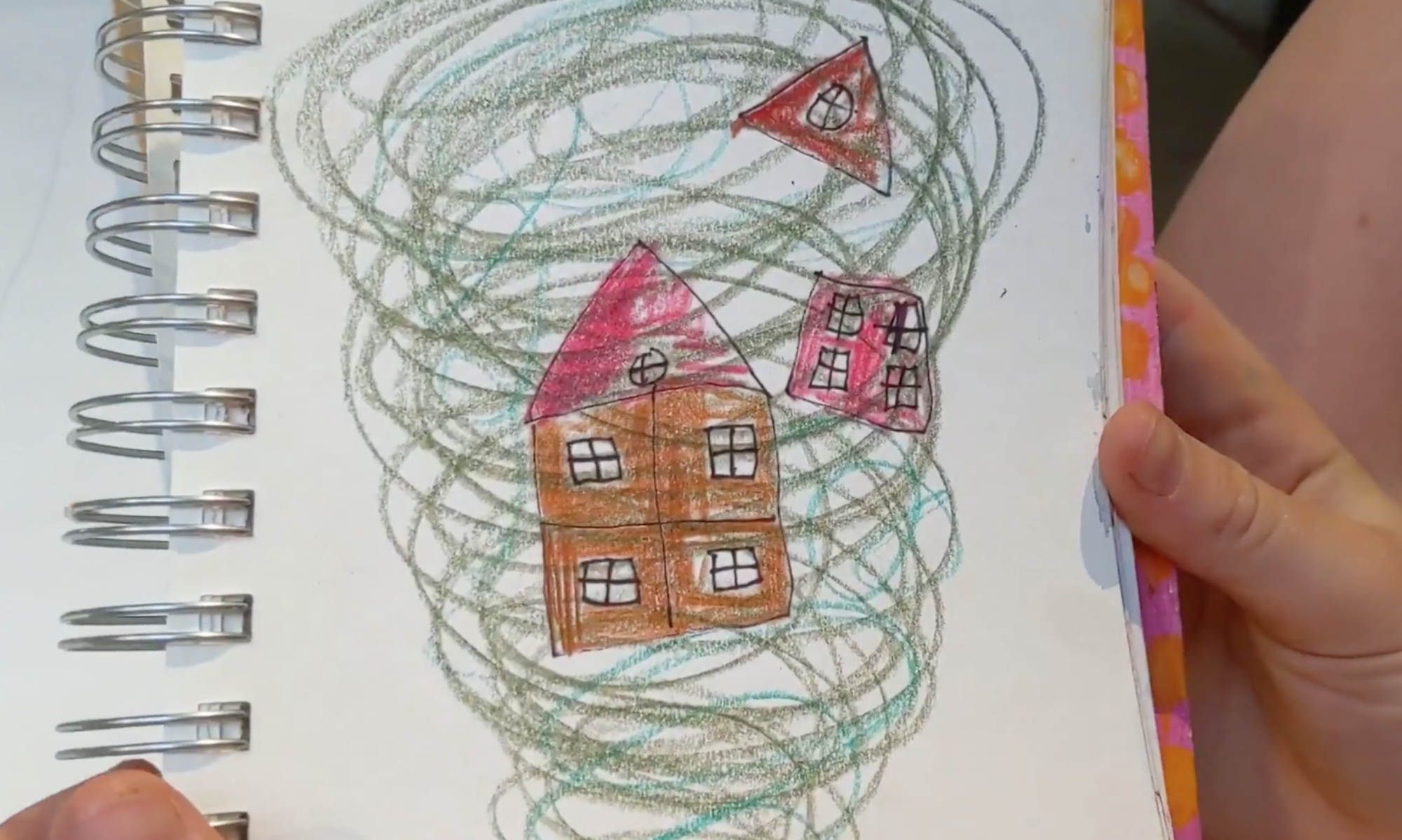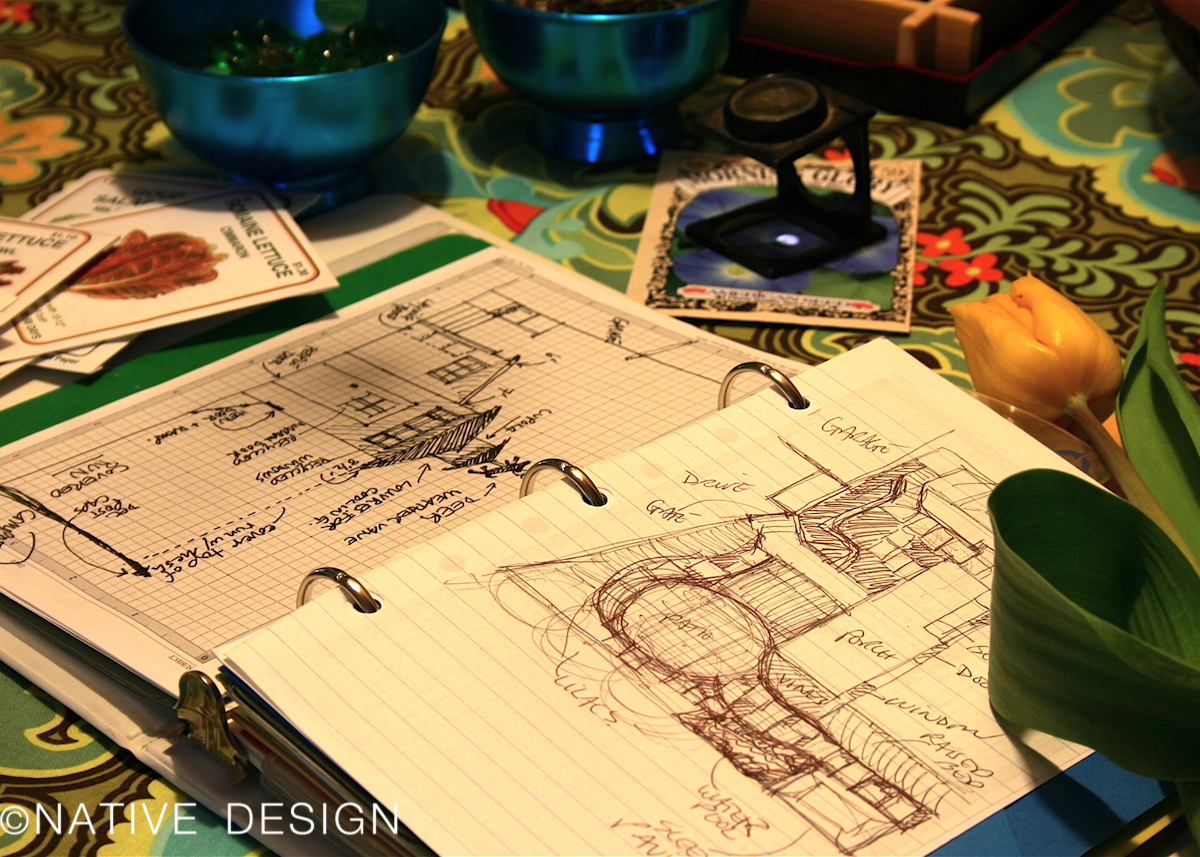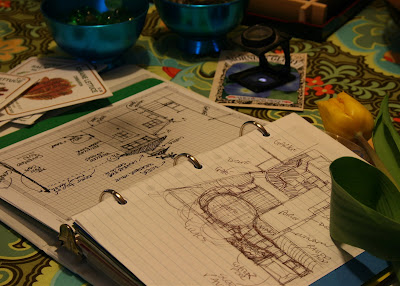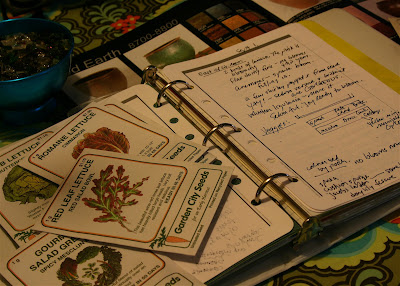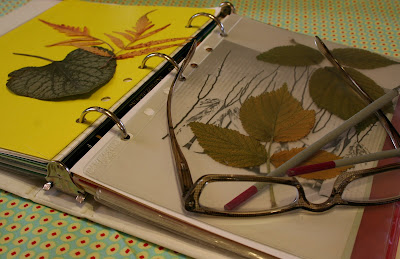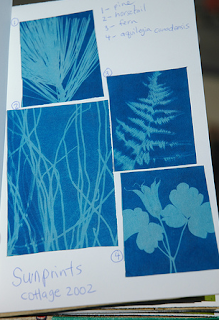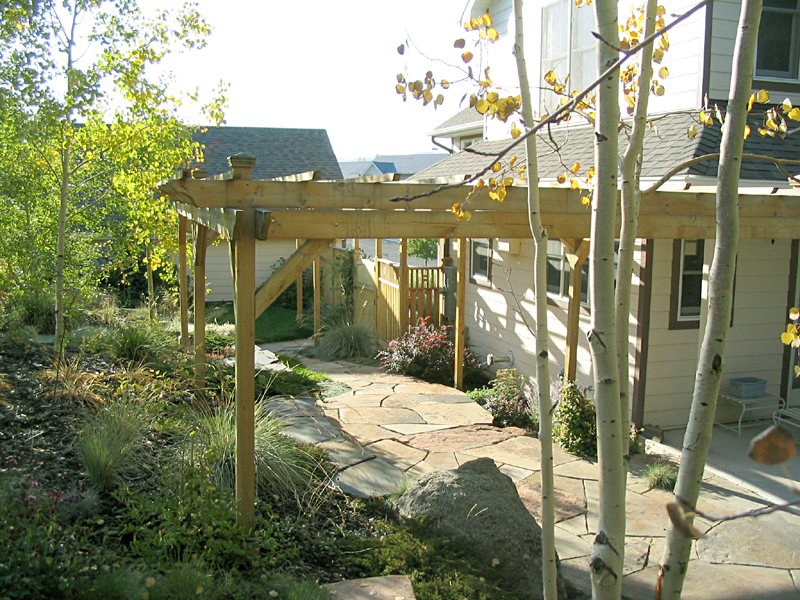The Soul and Its Symbols
Garden Journal: Now’s a Great Time to Start One
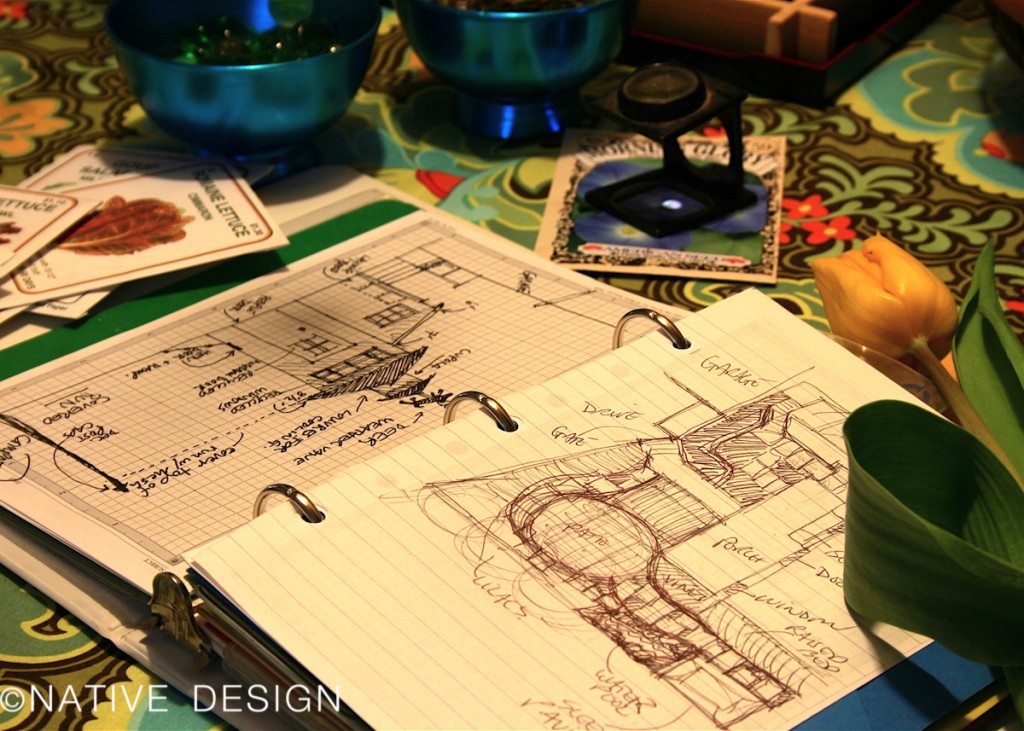
 I’ve kept a separate notebook or journal for my garden for years. Off and on. I’m not as disciplined as I’d like to be about keeping track of what is planted where; which plants are blooming when; what I’ve spent on the garden … or where I bought my materials, pots, and other stuff.
I’ve kept a separate notebook or journal for my garden for years. Off and on. I’m not as disciplined as I’d like to be about keeping track of what is planted where; which plants are blooming when; what I’ve spent on the garden … or where I bought my materials, pots, and other stuff.
Sometimes my garden journal is just a few pages in my regular sketchbook or journal. For the last few years, I’ve used a smallish 3-ring binder pages I have customized and punched to fit. I use different kinds of paper depending on what I’m recording on it: graph paper for recording my veggie plots and for sketching ideas for construction projects. Heavy sketch paper for botanical and nature sketches and for just doodling ideas. Vellum envelopes with holes punched in them, for keeping plant labels and other odds and ends (receipts, etc)… plastic sleeves with 3-holes, these are handy for seed packets, photos, loose seeds, etc.
I have my journal divided into sections with pocketed dividers – the pockets come in handy for keeping loose stuff. If you make your own journal, you can make sections to fit the kind of information you want to keep about your garden. Here are some ideas for record-keeping and inspiration:
- a plan view of the garden, drawn on plain or graph paper: this is not only to remember the layout of your plant beds and locations of special plants — but also to help you imagine improvements you might want to make
- weather records for our city and growing zone: first and last frost dates, rainfall, snowfall, and extreme events such as hail storms (which always seem to hit us hardest the week after we have set out our basil and tomato seedlings!)
- seed packets and plant labels: if you have a sheet for each plant, you can keep the packets in envelopes taped to the back of the sheets. Otherwise, a separate section for seed packets and plant labels is a good idea. I like to keep track of the nurseries where I bought potted plants
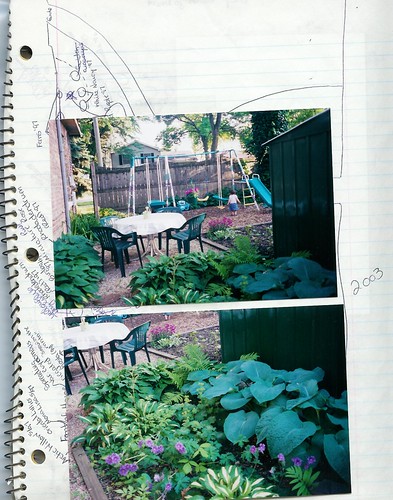 photos and/or sketches to document what’s growing throughout the year. I pair the photos with sheets on the individual plants. I also have a section for just beautiful photos of my garden
photos and/or sketches to document what’s growing throughout the year. I pair the photos with sheets on the individual plants. I also have a section for just beautiful photos of my garden
- garden tasks: wish I were organized enough to write down the dates I did (or should have done) certain tasks like weeding, planting and pruning. It would help with planning
- wish list: this is a fat section for me — there is always something I’d like to buy or make myself: wind chimes, plants, compost, a teak recliner, porch swing … or hardscape improvements I want: a deck, french doors, a little patio … dream on. Writing these things down or keeping clippings and photos helps me remember and prioritize. I had a garden pond on the wish list for years. A few years ago, my son, Mickey helped me make it a reality. So it works!
- clipped or photocopied articles, reference stuff from books and gardening handouts. This is a good place to keep reference materials from garden lectures or how-to courses, or instructions for making things for your garden
- use the journal to keep pressed leaves and flowers from your garden.
- Instead of pressing the plant parts, if you’re feeling creative, make sunprints using light-sensitive print paper.
- I keep a running list of wildlife I’ve seen in our garden, which is a certified wildlife habitat garden now
- quotes about gardening and my thoughts inspired by connecting with my garden
- ideas for cooking from the garden and recipes for salsa, pesto, quiche…
- I try to keep track of how much I spend in the garden. It’s always more than I thought! Sometimes I don’t keep the receipts, I just write the costs down kind of haphazardly
some links:
 lots more information about materials you’ll need and how to get started –they even have some templates you can download for plant record-sheets
lots more information about materials you’ll need and how to get started –they even have some templates you can download for plant record-sheets
- Keeping a Garden Journal: what to use for a garden journal and what to keep in it
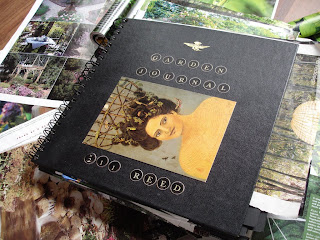 Bitter Betty: I love her sense of humor and highly recommend this blog post. Will her garden ever sit up and pay attention?
Bitter Betty: I love her sense of humor and highly recommend this blog post. Will her garden ever sit up and pay attention?
 Journaling Life has some good links to resources, along with ideas for what to keep in your garden journal. Thank you to Denise, Leslie, Gayla, Lisa and BitterBetty
Journaling Life has some good links to resources, along with ideas for what to keep in your garden journal. Thank you to Denise, Leslie, Gayla, Lisa and BitterBetty
Please click on the photos to find links to their photo pages.
Water Conservation in the Garden: Principles of Xeriscaping
World Water Day is tomorrow, March 22, 2013 and Earth Day on April 22 this year. Mother’s Day is on May 12th, a good day to honor our human mothers as well as our Earth Mother.
To celebrate World Water Day, I thought I’d write about water conservation, and include a number of photographs of gardens I have designed around Helena, Montana, using the 7 main priciples of Xeriscaping, or, as I like to say, WaterWise garden design. I hope you find some inspiration in these photos. If you have any questions about the gardens in this post, please email me or comment below. Thanks!

A colorful drought-tolerant vine that also smells delicious and attracts hummingbirds and butterflies, this hardy Honeysuckle vine also create shade and privacy on the back patio.

Front yards do not have to be just a few shrubs and trees surrounded by expanses of thirsty lawn. If you have a small property, make use of the front yard to create usable outdoor rooms. This waterwise garden provides plenty of privacy and several different activity zones in a little over 900 square feet. What was originally an open, dry lawn now has a 6 ft privacy fence, arbor and gate, two patios, a shade pergola and a colorful xeriscaped garden. (see concept sketch below)

More often than not, suburban back yards are just a weekend mowing and watering chore. Why not replace a huge lawn with a series of decks that are not only more attractive and easier to maintain — but add to the square footage of your liveable space? This deck in a WaterWise landscaped back yard provides at least four different “rooms,” one specifically designed for watching sunsets.

A privacy fence creates a whole different feeling in the backyard, making it perfect for quiet visits, reading or shaded dining on hot summer evenings. Birds are attracted to the running water in the pond, and butterflies feed on flowering perennials and vines.

Xeriscapes can include water features. Here, an overflowing urn appears to flow into a dry stream bed. The bright blue color and sound of bubbling water create a focal point in this garden.

Pondside plantings include native irises, corkscrew rush and tufted hair grass which will mature to a graceful arching clump grass

Xeriscaped front yards do not have to be all gravel, juniper, yucca and potentilla. In fact, a well-designed xeriscape can look much more attractive and welcoming than a mostly-lawn entry garden. Here, sumac, hosta and native ferns share a plant bed next to the front porch, where a Japanese “rain chain” directs roof runoff into a drainage pipe disguised by a dry stream bed of black rocks. Spilling onto the stone paved front patio are drought-tolerant groundcovers such as creeping thyme, artemisia and snow-in-summer.

A xeriscaped entry garden with just the smallest circular lawn for a cool green sitting spot. The rest of this front yard is slate walkways and patio, a Mediterranean-style gravel garden, and planted terraces with aspens for shade and privacy
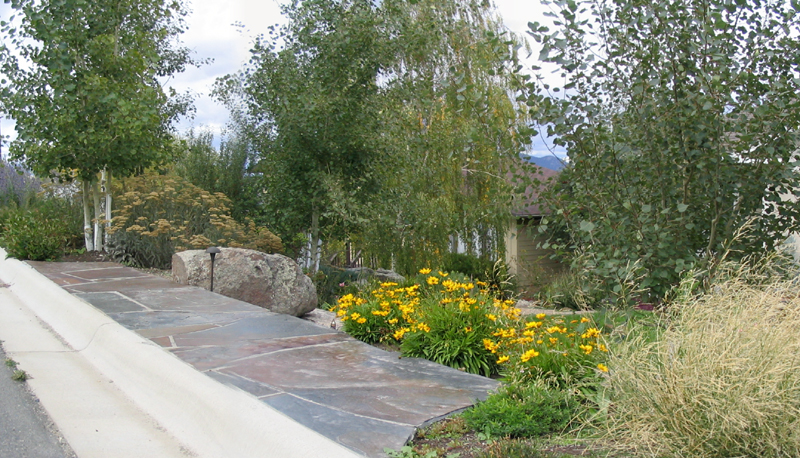 Slate paving provides a comfortable spot for guests to approach the front garden of this home. Steps leading down into the entry garden are flanked by aspen trees, daylilies, ornamental grasses and colorful flowering perennials.
Slate paving provides a comfortable spot for guests to approach the front garden of this home. Steps leading down into the entry garden are flanked by aspen trees, daylilies, ornamental grasses and colorful flowering perennials.

A grand entry experience greets guest to this home built on a steep slope above the road. There is no lawn at all in this xeriscaped garden. Instead the slope is tamed by a series of stone terraces and slate steps that create lots of liveable space on an otherwise unusable slope. The dramatic focal point of this planting is Karl Foerster Feathered Reed Grass.

Enter this driveway through a small grove of native aspens mulched with smooth river rock. The aspens frame visitor’s view of this grand brick home in the Helena Valley.

A drainage problem prompted design of this dry stream bed to handle roof runoff during storms. Boulders and pebbles meander through drought-tolerant shrubs and perennials with a clump of aspens. Daylilies, Siberian Iris, Coreopsis, Potentilla, Russian Sage and Arctic Willow make a striking accent planting near the front door of this home.

Xeriscapes can include vines such as this Hops vine to cover unsightly fences and block walls, or to create shade and privacy as in this photo. Here, the hops grows on a trellis on the west side of a porch, creating a cool spot to sit outside on hot summer evenings.

In our hot, dry Helena summers, shade is an important landscape element and fits well with any xeriscape design. Here, a pergola attached to the south side of this home provides shade not only for the stone patio, but also for some of the plants in the beds around it. Honeysuckle and Clematis vines are planted at the base of each post to eventually grow up and over the pergola. Aspens planted in clumps augment the pergola’s shade as they mature.

A cedar pergola planted with vines shades this stone patio and bench-height retaining wall. Xeriscape principles followed in this design include thoughtful planning, low-volume irrigation, drought tolerant plants located in groups according to their water requirements, low-maintenance, improved soil, shredded bark mulch to retain soil moisture, extremely small lawn area and a native grass meadow.

A xeriscaped back yard has two circular stamped-concrete patios shaded by a small aspen grove, stone terraces planted with native drought-tolerant plants and a very small lawn area.

This could be a front garden or back yard dining area. There is no lawn at all in this xeriscape. Instead the homeowners chose to install a paved patio surrounded by this stone retaining wall. Paved area tend to retain heat and can get uncomfortable in our hot summers. This patio has lots of cool shade provided by aspens and other trees, vines climing the walls and a cooling water feature that splashes down the stone wall, crisscrosses the patio and spills into a small reflecting pool. Plants are grouped according to the sun and water requirements, making watering and maintenance easier.

An alternative to lawn grass: these pavers are spaced a few inches apart with grass planted between them. This allows rainwater to permeate as well as gives visual interest and breaks up the expanse of hard material.

A native grass meadow was planted on this slope after construction of the home had disturbed the soils. The designer used all xeriscape techniques and mostly native plants to connect this contemporary home to it’s natural surroundings in the hills south of Helena.

An alternative to the big front lawn: a native grass meadow with boulder terracing punctuated with drought-tolerant mostly-native shrubs, trees and perennials.

To reduce the amount of bluegrass lawn in this front yard, the owners of this Helena Valley home put in large, bermed plant beds with many native plants such as aspen, potentilla, juniper, dwarf pine and artemisia. The soil was improved before planting and under the river rock mulch is a low-volume drip irrigation system

To reduce the amount of bluegrass lawn in this front yard, the owners of this Reeders Village home installed several large, mulched plant beds with drought-tolerant plants such as amur maple, flowering crab, potentilla, blue fescue, blue oat grass, rocky mountain juniper, dwarf spruce, snow in summer and artemisia. The soil was improved before planting and under the mulch is a low-volume drip irrigation system.

This Lakeside home replaced half of it’s thirsty bluegrass front lawn with a meandering gravel path, stone steps and a perennial garden under the mature trees. This is how visitors approach the front entry: much more welcoming than it was before these changes.

One principle of Xeriscaping is to group plants into zones according to their growing requirements, especially water requirements. Here, an isolated bed of shade-loving plants separates a lower patio from the upper one. Hosta, Maiden Pinks, Lady Fern and Coralbells thrive in the same bed.
To be continued … check back for more photos, more details and more inspiration!
We act as though comfort and luxury were the chief requirements of life, when all that we need to make us happy is something to be enthusiastic about. — Albert Einstein
Why Tears are a Good Thing
“There is a sacredness in tears. They are not the mark of weakness, but of power.
They speak more eloquently than ten thousand tongues.
They are messengers of overwhelming grief…and unspeakable love.”
~ Washington Irving
For a more practical view on tears, read this from Aeon Magazine.
Lessons from a Grandchild
“Sometimes I need
only to stand
wherever I am
to be blessed.”~Mary Oliver
I am babysitting my grandson, so my son and his wife can have an evening alone. I have been at their house a few days and have let Henry take the lead in deciding when and how much to trust his Montana Gma, how close to let her come. He gives me cues. I follow. He has started coming to me. Just a little. I am happy to have that.
So here I am in their cozy home, for a little while, alone with this sweet sleeping child. I hear him crying. I go to my grandson in his little bed on the floor in the corner of his parents’ room. He is crying in the darkness, woken from a dream, or maybe from a dreamless sleep … by something. A chill? A small sound? The cat stepping across his blanket? Or just coming to the light part of his sleeping when any little thing will make him drift up from sleep like a bubble of air rising in still water.
He is used to his mommy or daddy cuddling on the bed when he wakes in the night, so I try that… but I smell different. My humming voice sounds different. My body bigger, not mama’s not dada’s. He looks at me in the dark with wide eyes and cries some more. His daddy told me to try cuddling, try milk, try just rubbing his back. Try not to bring him out into the kitchen/living room into the light…well, that’s not working … so we go into the kitchen to make a bottle of milk.
He cries quietly in my arms. Watches me make the bottle. We go back into the darkened bedroom, wrap up in a fuzzy blanket and sit in the rocking chair. He pushes the milk on the floor. Not having that! I keep rocking. I whisper the song I used to sing to his daddy. I love you … bigger than a great big whale, softer than a bunny, greener than the grass. I love you farther than the farthest star, taller than a redwood tree, deeper than the sea… and within minutes he is breathing slow and calm, sleeping on my chest.
Regardless of how hard you try to follow the rules, to be good, you will always be led to what you’re meant to learn. The rhythm of things, of sleep and waking and grief. The movement. The heartbeat. The connection of breath to breath. This is what you needed to learn. To follow your heart. And that was always to sit holding him, breathing with your face resting on the top of his head, smelling the sweetness of his long curls and his soft baby skin. Tears wetting your cheek and the top of his head. Crying in the half-dark, not from sadness, or any sort of disconnect but from the wild and precious connection you feel with this small child. This child who possesses a piece of you. Who holds a big part of your heart in his chubby little hand and makes little sleeping noises against your chest.
In this moment. In the darkness. In the quiet warm house you know all you need to know and you stay rocking him for longer than you need to.
___________________
I end with an excerpt from another poem by Mary Oliver, Invitation:
… believe us, they say,
it is a serious thingjust to be alive
on this fresh morning
in the broken world.
I beg of you,…
It could mean something.
It could mean everything.
It could be what Rilke meant, when he wrote:
You must change your life.
___________________
Links for this Post:
- Thank you to Dani Donders for the (modified) use of her photo in this post.
- Dani’s blog
- And thank you to Mary Oliver for her always inspiring poetry.
- More about Mary Oliver
